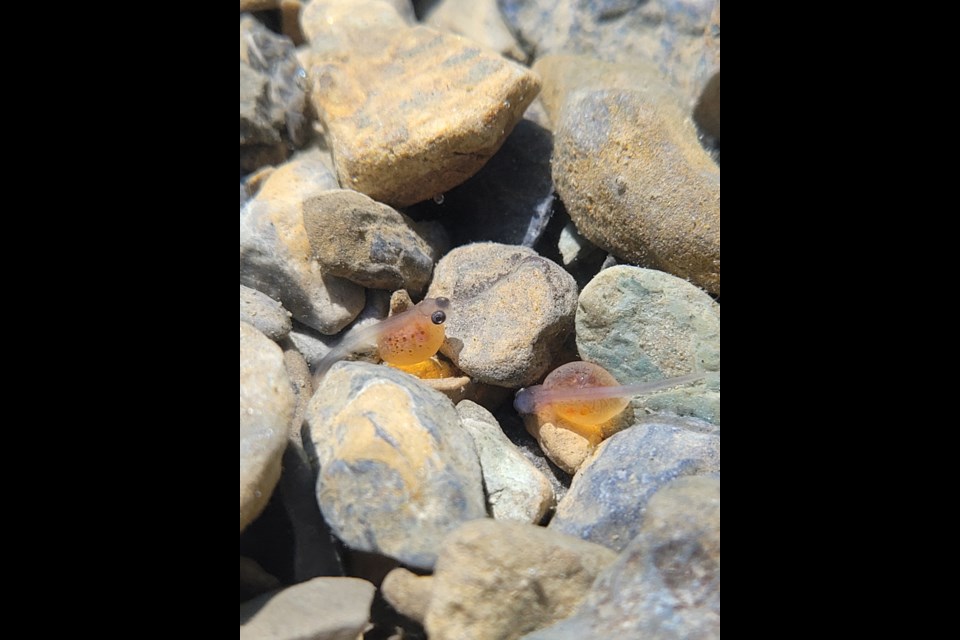BANFF – Parks Canada killed off thousands of non-native fish in a remote Banff National Park lake to make way for a threatened trout species.
Invasive brook trout, which choke out native fish like westslope cutthroat trout, were removed from Margaret Lake using rotenone – a natural fish toxicant derived from plant roots that enters the bloodstream of fish and quickly kills them.
After the second application of rotenone was put into the water earlier this month following the previous summer’s first round, Parks Canada staff stayed on site to apply a neutralizing agent to work alongside rushing water and sunlight to help safely break down the natural poison.
“We caught thousands and thousands of brook trout,” said Shelley Humphries, Parks Canada’s aquatic specialist for Lake Louise, Yoho and Kootenay field unit.
“When we do the rotenone treatment, about 20 per cent of the fish in the lake come up to the surface and then the rest sink.”
Now that the non-native fish have been removed from Margaret Lake, located about 23 kilometres north of Lake Louise, Humphries said she expects the threatened westslope cutthroat trout will be returned to their home there in 2025.
“We just need to first not get ahead of ourselves and make sure that we were successful with getting all of the brook trout out,” she said.
Using environmental-DNA, the team will be able to tell what species remain in the lake by scooping up a few litres of water for testing.
“If we pass that test, then we’ll be starting to look at the food web and make sure all the zoo plankton in the lake and the invertebrates have recovered,” said Humphries.
“Then, we’ll move to putting westslope cutthroat trout back into Margaret Lake.”
Because Margaret Lake’s outflow stream had a stepped cascade that fish can swim up in high water from the creek and nearby Hector Lake, Parks Canada had to create a fish migration barrier on the creek to prevent non-native fish from swimming back into the lake.
To do that, a section of the creek was blown up using controlled detonations to create a 2.5- to three- metre high waterfall, which will stop non-native species or hybrid cutthroat trout in Hector Lake from returning to Margaret Lake.
“If we want Margaret Lake to work, and to be able to successfully reintroduce westslope cutthroat, we had to make it a full barrier to fish passage,” said Humphries.
“The fish just can’t jump up it anymore, whereas before a motivated big fish could have gotten up it.”
Over the last decade, Parks Canada has been working hard to restore critical habitat for westslope cutthroat trout in Banff National Park at five alpine lakes – Helen Lake, Katherine Lake, Hidden Lake and Little Herbert Lake. Margaret Lake, the biggest and most remote of the five lakes, was the last.
Now listed as threatened provincially and federally, westslope cutthroat trout were once widespread within the Old Man and Bow River watershed, but over the last century have disappeared from all but 10 per cent of its historic range in Alberta.
After being stocked in the mountain national parks beginning in the 1940s, non-native fish like brook trout have flourished and squeezed out westslope cutthroat.
They are also in trouble in Alberta because of hybridization with rainbow and Yellowstone cutthroat trout, habitat loss and damage, and increased water temperature related to climate change.
With reintroduction of westslope cutthroat unlikely happening until 2025 in Margaret Lake in order to make sure all the invasive fish are gone, Parks Canada will turn its attention back to Helen Creek again next year.
Non-native fish have already been removed from Helen and Katherine lakes; however, there is no plan to put native fish in those water bodies because they were historically fishless lakes.
Humphries said e-DNA indicates all the non-native fish are out of Helen Lake, which was also treated with rotenone over two seasons, but the final results for Katherine Lake haven’t come in yet.
“If we’ve managed to remove all the non-native fish from both headwater lakes, then Helen Creek will be the place that we go next to restore fish,” she said.
For reintroduction projects, Parks Canada first must first get pure, disease-free adult westslope cutthroat from nearby lakes or streams.
“Then we take the eggs from the females and we take the milt from the males and then we release the adult fish back,” said Humphries.
After the eggs are fertilized stream-side, they are placed in a special incubator at Parks Canada’s office where they receive a constant supply of oxygen-rich water, similar to what is found at a fish hatchery.
Once eyes become recognizable – they look like two dark dots – the tiny fish are taken to where they are to be released. They are placed in stream-side incubators, which is basically a set up of PVC pipes and five-gallon buckets.
“After we put them in there, they finish their maturation from eggs to hatching in the streams where they’re going to stay,” said Humphries.
Last September, the aquatics team successfully reintroduced westslope cutthroat back into Hidden Lake, in the Skoki Valley. It was the first time the native fish had been in the lake in 50 years.
Humphries said about 5,000 more fry were released into Hidden Creek and Hidden Lake this summer.
“We are able now to see the fish that we put in the lake in the first year and we could see them in the creek… they seem to be doing just fine,” she said.
“It’s all very exciting.”




